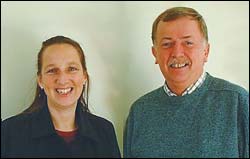Knocking on the strategic modelling door
27 September 2004
Sharing knowledge: Civil engineering senior lecturer Marianne Vanderschuren (left) with visiting Netherlands Professor Martin van Maarseveen
The availability of strategic models in the transportation field will increase rapidly because of the ease with which these models and their implementation can be produced nowadays.
This according to Professor Martin van Maarseveen from the Netherlands who visited UCT's department of civil engineering recently.
Thanks to Van Maarseveen, students from the Faculty of Engineering and the Built Environment transportation studies programme and Cape Town practitioners were able to gain an overview of strategic modelling in the transportation field - something that is not used in South African practice.
Van Maarseveen pointed out that strategic models are developed and used for research questions that cannot be adequately answered by traditional techniques.
"Depending on the issues at hand, it is likely that strategic model applications will be followed by and used in conjunction with more traditional models," he said.
"Just like any modelling activity, strategic modelling is an art. It is not an art in itself, but it aims to produce a tool for decision-making with a larger time horizon. Appropriate modelling produces results with an uncertainty that is small enough to answer decision-makers' questions."
Van Maarseveen emphasised the need for a model that is able to find characteristics of transport systems that will maximise levels of essential mobility and accessibility without exceeding available and affordable resources.
He said key factors to be considered include population dynamics and car ownership.
 This work is licensed under a Creative Commons Attribution-NoDerivatives 4.0 International License.
This work is licensed under a Creative Commons Attribution-NoDerivatives 4.0 International License.
Please view the republishing articles page for more information.










